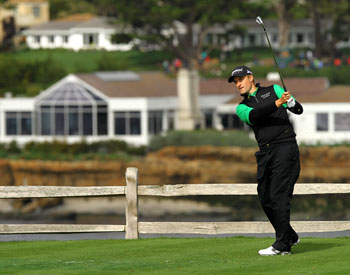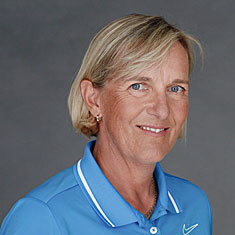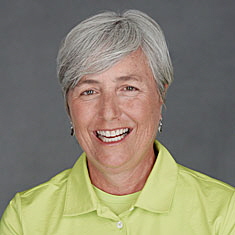Playing Golf in the Zone: An Interview with the Creators of VISION54
 John: We have with us today two of the premier teachers and coaches of golf on the planet: Pia Nilsson and Lynn Marriott of VISION54. Pia and Lynn are getting ready to release a bundle of iAwake Technologies tracks for those who are interested in improving their golf game—deepening it, working on their inner game, changing their brain, getting focused, and doing all the stuff that makes golf such a compelling game in the first place.
John: We have with us today two of the premier teachers and coaches of golf on the planet: Pia Nilsson and Lynn Marriott of VISION54. Pia and Lynn are getting ready to release a bundle of iAwake Technologies tracks for those who are interested in improving their golf game—deepening it, working on their inner game, changing their brain, getting focused, and doing all the stuff that makes golf such a compelling game in the first place.
Lynn: I’m really excited about our partnership with iAwake and bringing the iAwake products to golfers, because they’ve made a huge difference in my life—not just with my golf but also personally.
Pia: There are so many technical things to learn about golf, but it’s always a human being who is playing golf. So whatever goes on with the body, mind, or emotions really affects the golf game.
Lynn: Pia, you’ve meditated for over 20 years, and I got introduced to meditation about 15 years ago, and we both saw great benefits to meditation and also knew that meditation is a discipline that golfers needed to learn. In 2000, we invited Michael Murphy to spend a day explaining meditation and the whole body-mind-spirit integration to a group of around 30 coaches. It was just fabulous because he really took out the mystery of meditation for us and for all the golf coaches in the room that day.
Pia: When I started using iAwake tracks, I felt that my meditation got incredibly better. I started doing it more and more, because I felt doing it helped me every day. It’s like a tuning fork—I become more connected to who I am and to my values (which is especially hard always being busy and around a lot of people), plus I totally believe in the health benefits of it and developing my brain capacity.
 Being coaches of golf, one thing that we come across all the time is that for the few seconds that you actually hit the golf shot, it’s essential to learn to be present and not have any cognitive thoughts. You have to be present through your senses. Many people have problems with that, even though it might only last five to ten seconds. The second thing is that golfers have so much time in between shots, and they underperform because their self-talk is not very productive. So, when people start meditating a bit, they find they become much better both in the peak performance zone of hitting a shot and managing the mind in between shots. It improves their performance a lot.
Being coaches of golf, one thing that we come across all the time is that for the few seconds that you actually hit the golf shot, it’s essential to learn to be present and not have any cognitive thoughts. You have to be present through your senses. Many people have problems with that, even though it might only last five to ten seconds. The second thing is that golfers have so much time in between shots, and they underperform because their self-talk is not very productive. So, when people start meditating a bit, they find they become much better both in the peak performance zone of hitting a shot and managing the mind in between shots. It improves their performance a lot.
John: I never thought about it like that. You’re walking, you’re driving the cart for five minutes or so until you set up, and the time that you focus and actually do the shot is very brief.
Lynn: Yes, and those are two very different states. Many golfers underperform because they don’t know how to manage all that downtime. Their mind can just go crazy over what they’re going to shoot, being mad about past holes, and that kind of thing. They don’t know how to manage their self-talk (or conversations with others) and then come back to being present when it’s their turn to hit.
Pia: There’s also a lot of emotional stress—people getting angry, frustrated, nervous, anxious, you name it.
Lynn: We often see everything from euphoria to depression; with golfers this can all be on the same hole. (Chuckles).
Pia: What happens on the golf course is the same as what happens in life. When golfers learn to manage their state, their mind, and their emotions, the beautiful thing is that we don’t have to say anything. They naturally realize, “Wow, I can use this at work,” or “I can use this with my family.” Through the game, we learn things that we can use in all of our roles outside of golf. This has been a wonderful addition to what we do.
John: What we’re really talking about is “depth golf”—playing the game at a very deep level. When golfers take the game to its real potential, what do they say to, “Why do you play golf?
Lynn: That’s a question that we personally ask ourselves and for the players who come to us for coaching, we frame it this way. “What is your spirit of the game?” “What spiritual discovery or adventure do you want to have with golf?” Sometimes we just say, “Why do you play golf? Why do you spend the time, energy, and money doing it? What is the intrinsic motivation, regardless (for the professionals we coach) of the money that you’re going to make and regardless of lowering your handicap or winning the match?”
Pia: Yes, if that question isn’t clear, nothing else works. It’s something that we come back to a lot. And a lot of sports science backs this up reporting that sustainable performance is a balance of the extrinsic motivation and the intrinsic. Extrinsic motivation is what everybody talks about: lower handicap, being famous, making money. But the intrinsic motivation is what you love about it beyond the scoring and the outcome. It’s like the oxygen of the whole golf game.
 Lynn: One of the things that I love about Michael Murphy’s book Golf in the Kingdom is that he touches on that really deep spiritual place that golfers go to. That’s what golfers really love about the game. When they have experienced that deep spiritual space, even if just on a couple of shots, they want more. They’re drawn to it. That’s what all of the searching is about. “I’ve been there, even if it was just for one shot today, and I’d like to go there more.” We started looking at what state the brain needs to be in to access that place through some brain mapping, but obviously meditation, and certainly the iAwake technology, helps people access that even more quickly and more efficiently.
Lynn: One of the things that I love about Michael Murphy’s book Golf in the Kingdom is that he touches on that really deep spiritual place that golfers go to. That’s what golfers really love about the game. When they have experienced that deep spiritual space, even if just on a couple of shots, they want more. They’re drawn to it. That’s what all of the searching is about. “I’ve been there, even if it was just for one shot today, and I’d like to go there more.” We started looking at what state the brain needs to be in to access that place through some brain mapping, but obviously meditation, and certainly the iAwake technology, helps people access that even more quickly and more efficiently.
John: What are you finding with your students who are using iAwake, and what are you noticing about their experience and about their progress?
Lynn: We have one client, and I love her because she is a businesswoman who just likes results (chuckles), and the email we got from her said, “I’m playing better.” (Chuckles). That was her feedback. Then, afterwards, she told us that depending on which track you’re listening to, it helps with the anxiety of anticipating an important round of golf, and that kind of thing.
Also, we emphasize in our coaching that people do some reflection after a round or a practice session. Using the iAwake tracks to access a deeper reflection state is helpful, so they can reflect on why it was maybe a not-so-good performance round, but can also access what was good about it. They need to be in a different brain state to be able to do that.
John: Yes, you’re absolutely right. The meditation and the iAwake tracks open us up to those states, so that we can begin to sense into that deeper intuitive wisdom that is beyond the intellectual brain, where we begin to know and to flow—and time begins to do some strange things. You kind of know where the ball’s going to go. As soon as you hit it, you can sense into a deeper experience, where the veil between the merely exterior experience of playing a game or being conscious begins to melt with the interior dimensions.
Pia, Lynn: Yes, exactly.
John: We’re so exterior-focused in our culture. We’ve achieved great things that way, but the interior dimension has been so neglected. Ken Wilber has said that sport is a great, unacknowledged religion in the U.S. When we’re watching a great practitioner or a great golfer do their thing, there’s a sense of awe that is right up there with holiness, or basically the same thing. Or when we hit the ball ourselves—we hit the putt and it goes in—there’s a moment of pure gatheredness, stillness, beauty, ecstasy, that’s just extraordinary.
Pia: That’s why we feel so fortunate, being coaches and in the year 2014, because we feel that with the science that exists now about the brain and human performance, it’s easier, even for many of the more left-brained, intellectual people, to actually understand more of their inner world. It’s easier to talk about it without it sounding vague, and it makes it easier to make the shift to looking at both one’s inner and outer skills. Sport is a beautiful place, because at first you want to play better, and then you realize that to play better, you need to know more about your inner world. When you discover that, it makes your whole life happier. And you thought you were only coming to hit better golf shots!
John: Our sports, our music, and our art become a yoga, when we learn how to put the time in, do the hard work, get the coaching, get the expertise, but also pay attention equally to the inner game, which this technology allows us to do. In other words, it’s very hard to stay with a traditional meditation outside of a monastic discipline, but the iAwake tracks anchor you down into these deep states—even though it’s still a discipline you have to work at—so many more of us can stay with it and we begin to start feeling the results very quickly.
Lynn: I so connect with that because of the efficiency with which I can get into this state with the iAwake tracks that I couldn’t with traditional meditation disciplines. I just couldn’t get there; I would find myself wandering. But with the iAwake tracks, I come out so refreshed, or whatever, depending on what my intention was when I put the tracks on. It’s just a whole different, consistently deep level that I never got to before. Well, I shouldn’t say “never,” but it was more fleeting.
I remember when we found iAwake, I got this total hit that this is the real stuff, because it is actually going to help people stay with this discipline in a more efficient way. It’s certainly been that way for me. It’s been miraculous for me.
Pia: One of the things that’s good and fun with the iAwake tracks, too, is that there’s so much variety. That’s another thing that’s been very good for us with golfers. Many come to us and say, “I want to learn to be consistent,” and we always have to tell them that that’s not really achievable. The goal is to be a master of variability, because not only are the game and weather dynamic, but you as a human being will be dynamic for the rest of your life. Everybody knows that every day on the golf course is different.
For us to have the tools to be honest and check in every day—How’s my body? How’s my mind? How are my emotions?—and then have different tracks that can help us (since every day is different) has been very, very useful for us. The abundance of tracks fits our philosophy of becoming a master of variability; to manage ourselves, we have more than one choice.
John: Do you use visualizations yourselves and when you’re teaching your students?
Pia: Yes, we do. We prefer to call it imagery, because we believe in using all of our senses, not just the visual. We want golfers to identify the things they do when they play well. Most people know what’s wrong with their game; very few know what they do when they play well. We want them to become experts on both their states and their skills when they are playing well, to catch on to that using imagery in the first person—what they see, what they feel, what they hear—and then spend time every day doing that.
Lynn: It’s obvious that when you’re playing well, you’re hitting better shots and putts are going in the hole, but we’re more interested in the actual interior experience of playing well.
Pia: When they get it, they might say, “Wow, when I play well, I really visualize the ball flight clearly in my mind’s eye.” Or, “When I play well, I realize I don’t have other thoughts about the shots,” or “When I play really well, my shoulders are much more relaxed.”
Lynn: Tiger Woods said this in regard to visualization, “I don’t see my shots in all of those dimensions like shot tracker when you’re watching the PGA Tour on television. I don’t see it like that. But I feel the target in my hands.” And that’s exquisite. That is a very obvious sensation that Tiger experiences when he’s playing well, and he’s said it many times.
Pia: We keep getting answers like that even from amateur golfers. They just need to start looking there. We ask them, and friends they trust to keep asking them, too, what do they notice that’s different when they play well compared to not playing well? When you want to play well more often, you first need to know how you do it.
John: So, when people get down to the deep meditative states that iAwake makes accessible, then they do a kind of imagery thing? What is it like to drive really well, feel the wind, smell the air, feel your feet on the ground, your hands on the club, feel the swing and when the ball connects…
 Pia: Yes, absolutely we do that. And from the first person perspective—not like you’re watching yourself on the screen.
Pia: Yes, absolutely we do that. And from the first person perspective—not like you’re watching yourself on the screen.
We had one really good golfer who said, “Wow, it’s so different when I do it from that first person perspective. It’s much better that I do the imagery about all the things under my control.” It could be the breathing, the attention level in the body, the state of mind—not so much the course the ball flies or the outcome, because when she did too much about the outcome, she would go out on the golf course and then get disappointed if the way she hit her shots didn’t match up to how she had imagined it. So, that was a really cool distinction. She said, “But when I do it with all the other things, it has a great effect.”
John: Yes, and that’s so spiritual. You show up, you pay attention, you speak your truth, but when it comes to the actual outcome, that’s in the hands of the golf gods, or the universe, or spirit, or whatever that mystery is. All we can do is put in the necessary time practicing, and practice wisely and skillfully. Then we just let her rip and see what happens.
Pia: Exactly.
Lynn: As Pia said earlier, we’re trying to get golfers to understand that this whole experience of playing golf is learning to manage yourself, your mind, your body, your emotions. There’s your spiritual motivation or your reason for playing, but it always comes back to having a self-awareness and then managing from that self-awareness. I would also say developing the ability to be more self-referencing and self-regulating. So, self-awareness, self-referencing, and self-regulating.
Some of the studies that have come out over the last couple of Olympic Games report that with athletes across all sports, those who have the more sustainable performance are able to perform more consistently and they’re able to self-reference and self-regulate to a much greater degree than others.
Pia: In golf, you keep a scorecard of how many shots you have, but we stress another scorecard. We have a scorecard called Playing Focus Scorecard, which is a process scorecard. People learn early on that it’s more important to score well on the process scorecard—something under their control. So, for example, people can have the goal that if they commit to a decision, they get the point. They find a game within the game that they can win, creating small habits in the process, and they learn from the beginning that the score they turn in is going to get better and better, the better they get at the process. We work a lot with that, but it needs to be practical and applicable when they go out on the golf course.
John: So we’re saying self-mastery is the method and the goal.
Pia: Yes, exactly.
John: I love what you said about how when you go into the golf course, you’re entering the temple. You’re in grass, or the trees, or the desert, or next to the ocean, and you feel the wind, you smell Mother Earth. This is the time to enter into that zone of concentration and meditation, “I’m just there,” and it’s very beautiful. A lot of people that wouldn’t otherwise get outdoors, do get out because of golf, and if you can increase their mindfulness of what is going on around them and being very present, that’s going to add an intrinsic value to the whole experience that they will take with them.
Lynn: Yes. We had the opportunity to play Cypress Point at the end of April, as a couple of the members there have been to our golf school and have received coaching with us. They were so gracious to invite us to come play at the most beautiful golf temple, or church—the most beautiful golf course that you’ll ever see in the whole world.
I asked one of the ladies who had been to our golf school, “What changed for you when you played golf after having gone to Vision54?” She said, “Well, you know, I’ve played some better golf, but the biggest change for me is that I’m just going to enjoy the experience no matter what.” My heart just glowed when she said that. The second thing she said is, “You guys taught me that I’m in control of that.” (Chuckles).
___________________________________________________________________________
Adapted from iAwake Technologies’ free, weekly teleconference call on June 4, 2014.
Join our weekly calls!
To receive information on how to join the weekly iAwake coaching calls that John leads, sign up for the free meditation download and you’ll be put on the email list. You can also access the phone-in information on our Teleseminar page.
___________________________________________________________________________
Lynn Marriott is regarded as a true pioneer in the world of sport. After more than 20 years on the leading edge of how golf is taught, Lynn is today globally recognized as co-creator of the VISION54 principles, best-selling co-author and world-renowned coach.
While Lynn’s knowledge of the golf swing is unmatched, her heartfelt and intuitive approach to coaching golf and integrating its elements has created a powerful shift in the games and lives of golfers, coaches and individuals around the world.
Among Lynn’s notable students are LPGA players Suzann Pettersen, Ai Miyazato, Na Yeon Choi, Brittany Lang, and PGA Tour player Kevin Streelman.
___________________________________________________________________________
 Pia Nilsson has enjoyed an extraordinary career that has led her to be world-renowned as co-creator of the VISION54 principles, best-selling author and coach.
Pia Nilsson has enjoyed an extraordinary career that has led her to be world-renowned as co-creator of the VISION54 principles, best-selling author and coach.
For many years now, Pia has been internationally regarded as a leader in the coaching arena. As such, she stands apart in the golf and sports world as an intuitive and elevated thinker, whose teachings continue to have a profound influence on coaching in golf, sport, business – and life.
Well-known for her role in coaching Annika Sorenstam on her path to super-stardom, Pia’s other notable students include LPGA Tour players Suzann Pettersen, Ai Miyazato, Brittany Lang, Na Yeon Choi and PGA Tour player Kevin Streelman.
___________________________________________________________________________
 John Dupuy is the CEO of iAwake Technologies and the founder of Integral Recovery, a holistic addiction treatment approach inspired by Ken Wilber’s Integral Model. He is also the author of the award-winning book Integral Recovery: A Revolutionary Approach to Alcoholism and Addiction, recently published by SUNY Press. As a pioneer in the use of brainwave entrainment in therapy and personal development, John has dedicated his life to helping others deepen their spiritual practice and transform their lives.
John Dupuy is the CEO of iAwake Technologies and the founder of Integral Recovery, a holistic addiction treatment approach inspired by Ken Wilber’s Integral Model. He is also the author of the award-winning book Integral Recovery: A Revolutionary Approach to Alcoholism and Addiction, recently published by SUNY Press. As a pioneer in the use of brainwave entrainment in therapy and personal development, John has dedicated his life to helping others deepen their spiritual practice and transform their lives.
___________________________________________________________________________
Leave your comments below
1 Comments
Leave a Comment
You must be logged in to post a comment.





Loved the talk this blog post came from!